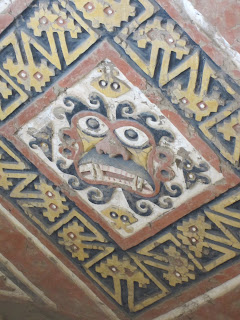Heard of Peruvian hairless dogs?
What about Peruvian Paso horses?
| Stock photo, but what we saw - camera battery was flat |
Nup, neither had we. How long were the Incas part of Peruvian
history and what happened before they arrived?
Well I guess we found out all about these pressing questions that had
been keeping no-one awake today.
We arrived in the fairly unscenic port of Salaverry this
morning as an access to the rather more scenic city of Trujillo in northern
Peru.
It, like Peru’s economy is growing rapidly – the city is
full of half-finished houses: they build what they can afford and finish it
later when a few more dollars come in.
Eaten any Peruvian asparagus lately? Well the locals don’t touch it as it’s
1.
Too expensive for them to eat
2.
Not part of their culture anyway
3.
A lifesaver of their economy – so eat with
relish as we did with dinner ce soir.
We had a fascinating day looking at (UNESCO heritage again) relics
from two pre Inca cultures and one post Spanish conquest in this lively and
historical city. The excavations are
relatively recent: 1964 for Chan Chan and 1991 for the Sun and Moon
temples. Refreshingly, we were a group of relatively few tourists wandering these developing but amazing locations dating from 100 AD to 1300
AD.
As an added bonus after these rather strenuous tours we had
a lunch at a local ranch watching the Peruvian Paso (walking) horses whose
agility is quite amazing – and very treasured by the population - see above. We were also treated to a display of Marinera dancing – they were trying to set up a Guinness
world record for this type of dancing, in central Trujllio, whilst we were there.
Trujillo was named by
conquistador Francis Pizarro in 1534 after his hometown in Spain – many of the
elegant two storey buildings are now one storey after being razed by
earthquakes in the past.
We visited a
very swish home - now a bank
where Simon Bolivar had signed the Independence Treaty for the
city in 1820.
 |
| Desk where independence treaty signed |
The Incas were actually in the area for only 100-150 years before being conquered by the Spanish in the 16th C - the
very proud Moche people (pronounced something
like Motchay) were in residence beforehand and had established huge adobe
temples only recently discovered;
 |
| Moche Temple of the Moon c 200 AD |
 |
| Detail of the Moche god - Temple of the Moon |
they in turn were conquered by the Chimu people who established Chan Chan c 1200 AD - much destroyed by erosion and rain due to its coastal location; excavation and restoration continues.
 |
| Chan Chan ruins - external walls were originally 12 metres high |
The grey on grey landscape and the erratic rainfall from El
Nino has actually helped to preserve yet destroy these adobe structures – the heavy
rainfall every 50 odd years was seen as a bad sign from angry Gods yet
irrigation has been used for thousands of years to propagate the corn and
potatoes as staple food for the locals – though sugar cane and rice has also
entered the equation.
We also saw the coastal town of Huanchaco where reed fishing boats have been used (and are still used) for hundreds of years, but is now also on the surfing trail
There’s also the wonderful Pisco Sours: a lemon/lime drink made with the grape distilled Pisco and limon, sugar syrup and egg white - it's a source of debate as to its origin between Peru and Chile - a bit like the Pavlova debate between Australia and New Zealand. Also it's rumoured there are very tasty beers – more to come
on those. Off to Lima tomorrow for three days as we (quelle horreur) chose not to got to Machu Picchu.




The question thats keeping me awake is what did the Inca's do after night out on those Pisco Sours ... no hair of the dog!!!
ReplyDeleteJe suis impatient de voir le rapport pour les bières savoureuses, accompagnés de photos de l'panama.
ReplyDeleteI would love to see the Sun and Moon temples. The single story buildings look Weird but cool. Great to hear your enjoying yourselves.
ReplyDeleteHave just been watching a new documentary on lost south American civilisations where they focused on the "chchhapoya" people (cloud people) of Peru. They had amazing cliff face tombs called 'chulpas' that are way more impressive than the Phillipines and I have no idea how they manged to climb them.
ReplyDeleteIn the north of Peru they have discovered evidence of live and artifacts agriculture dating back to 6000 BC! We didn't get to see this, but as a country certainly warrants a return visit.
Delete